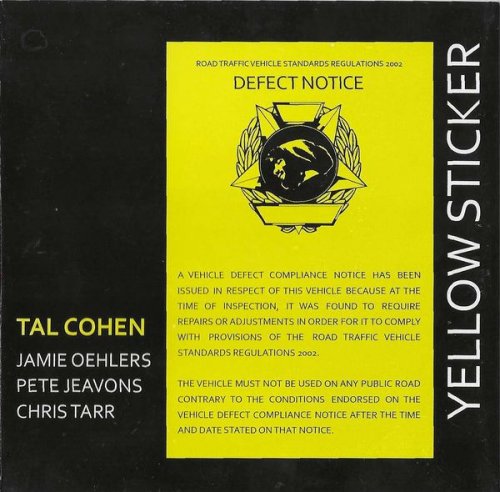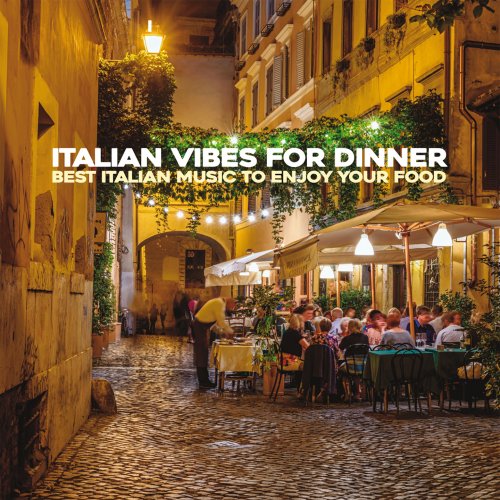Elena Maria Gaia Castini, Feyza Nur Sağlıksever - Fantasies, Nocturnes and Tarantellas: Italian 19th-Century Music for Flute and Harp (2025)
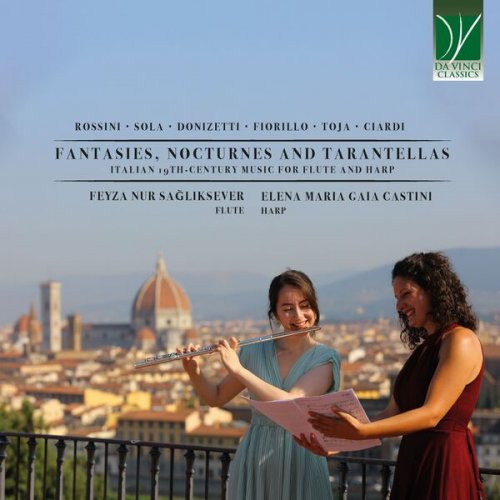
Artist: Elena Maria Gaia Castini, Feyza Nur Sağlıksever
Title: Fantasies, Nocturnes and Tarantellas: Italian 19th-Century Music for Flute and Harp
Year Of Release: 2025
Label: Da Vinci Classics
Genre: Classical Harp, Classical Flute
Quality: flac lossless (tracks)
Total Time: 01:03:31
Total Size: 264 mb
WebSite: Album Preview
TracklistTitle: Fantasies, Nocturnes and Tarantellas: Italian 19th-Century Music for Flute and Harp
Year Of Release: 2025
Label: Da Vinci Classics
Genre: Classical Harp, Classical Flute
Quality: flac lossless (tracks)
Total Time: 01:03:31
Total Size: 264 mb
WebSite: Album Preview
01. Andante con variazioni
02. La Marziale, Fantasia Concertante
03. Sonata Larghetto, Allegro Gallemberg
04. Sonata, Op. 36 No. 2
05. Notturno, Op. 9
06. Fantasia originale in F Major, Op. 122 Il Pifferaro
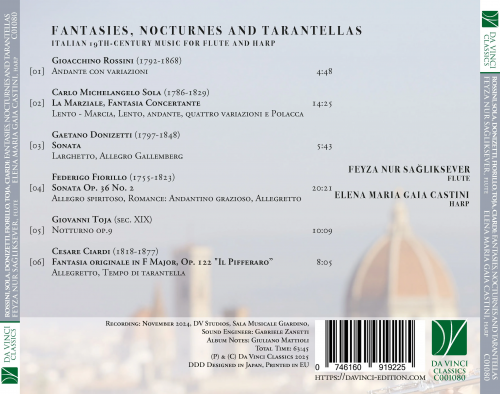
During the first half of the 19th century, when a new successful Opera was released, publishers promptly promoted transcriptions and paraphrases to spread catchy themes to the public. Thus, famous Opera Arias were adapted into salon pieces for various solo instruments or small chamber ensembles, often featuring the Harp and Flute. At the same time, an original repertoire was also developed for these two instruments: compositions not directly related to theatrical works but nevertheless influenced by the contemporary operatic style. This type of chamber music responded to the bourgeois taste of the time, which saw the flourishing of domestic ensembles and amateur virtuosos eager to perform elegant and brilliant music – such as Mozart’s famous Concerto for Harp and Flute K299, commissioned years earlier by the Duke of Guines, Adrien-Louis de Bounières (1735-1806), flutist, and his daughter, harpist and pupil of the composer. The Harp and Flute duo, as evidenced by the pieces presented on this disc, was particularly appreciated for its timbric contrast and for its ability to evoke atmospheres that were both pastoral and brilliant.
The first composition is by Gioacchino Rossini (1792-1868), one of Italy’s leading Opera composers. The Andante con variazioni is based on the theme ‘Di tanti palpiti’ from his Opera Tancredi (1813). The composer himself supervised its publication in Naples around 1820, in an original version for Harp and Violin – an instrumentation that was easily adapted to the Flute as early as the 19th century. The Andante opens with a short introductory Adagio, followed by the cantabile exposition of the theme in F major, which is then elaborated in a series of virtuosic variations. Although this is to be considered salon music, Rossini’s hand is recognisable in its formal elegance and melodic charm. The variations alternate moments of lyrical delicacy with others of technical vivacity, recalling the bel canto style and at the same time highlighting the technical skills of the performers.
Michelangelo Sola (1786-1829) from Piedmont, described by his contemporaries as a ‘great Flute player and distinguished composer for his instrument’, wrote the second piece. He became a Flute player in the orchestra of the Real Teatro in Turin, while also studying composition and producing a considerable amount of instrumental music, which was received with general enthusiasm. Some of his works were published in Paris – duets, trios and quartets for Flute and strings – demonstrating his talent as a composer and virtuoso. La Marziale is a fantasia concertante for Flute and Harp (or Piano) that perfectly embodies both Sola’s Flute virtuosity and the patriotic style of the time. The piece is structured in several sections: a slow introduction prepares the entrance of a march followed by a return to the initial Lento, and then an Andante cantabile that exposes the main theme. On this theme, Sola builds four brilliant variations, culminating in a final Polacca of virtuosic momentum. The form is reminiscent of the 19th-century fantasia with variations, combining the rhythmic pomposity of the march – very much in vogue at the time, in the post-Napoleonic spirit – with the elegant grace of the polonaise, often used as a brilliant finale. In the absence of any explicit references to specific Opera Arias, La Marziale can be considered an original work by Sola, probably conceived to highlight both the flutist-composer’s abilities and the timbric potential of the Harp.
The Sonata in G minor is an early work by the well-known Bergamo Opera composer Gaetano Donizetti (1797-1848), dating from around 1823-24. The manuscript preserved in Bergamo does not bear the title ‘Sonata’, which was later attributed to it by publishers, and is presented as a single piece in two parts, modelled on the form of an Opera Aria. The Larghetto in G minor serves as an introductory cantabile section: the Flute (or Violin) plays a melancholic and gently ornamented melody, clearly inspired by bel canto lyricism. This is followed seamlessly by the Allegro in G major – called ‘Allegro Gallemberg’ in some sources, probably in reference to a theme or style associated with the composer Wenzel Robert von Gallenberg (1783-1839). The piece offers the listener a small glimpse of Donizetti’s style: formal elegance, vocal melodies transferred to the Flute, and a final brio that foreshadows the energy of his future comic Operas.
Federigo Fiorillo (1755-1823), a cosmopolitan composer of Italian descent whose fame today is mainly linked to his 36 Capricci for Violin, is the author of this Sonata in three movements. His career took him on tour throughout Europe (St Petersburg, Paris, London), where he published over seventy opuses with more than two hundred compositions, including sonatas, divertimentos, serenades and arrangements of popular melodies. These were often pieces designed to appeal to the public’s taste, fitting into the fashionable genres of the time – brilliant pieces for salons and private concerts with a good formal structure but not too daring from a harmonic point of view. The Sonata op. 36 no. 2 for Harp and Violin (or Flute) is one of the two sonatas that Fiorillo dedicated to this combination. Probably published between 1810 and 1815, the Sonata is divided into three movements. The Allegro spiritoso presents a brilliant theme punctuated by scales and arpeggios in the galant style. In the Romance, the lyrical heart of the Sonata, there are pre-Romantic accents, a more intimate expressive feeling that anticipates 19th-century sensibility while remaining within an elegant and restrained phrasing. The concluding Allegretto has the character of a light rondo.
We know relatively little about Giovanni Toja (active in the first half of the 19th century). Sources indicate that he was an amateur composer (apparently, he trained as a guitarist) working around 1830-1850, probably in the Milan area. Despite this, his output was far from negligible. Over thirty of his compositions were published by Ricordi between 1826 and 1861. These include several chamber pieces featuring the Flute, an instrument for which he clearly had a fondness. The Notturno op. 9 was published in Milan in 1830, a testament to early Italian instrumental Romanticism. The title immediately recalls the famous contemporary compositions for Piano by John Field and Chopin. The character is that of a nocturne: it begins with a melancholic theme, entrusted to the Flute, supported by a soft and continuous arpeggio accompaniment of the Harp. There are modulations in minor and more intense passages, but the music maintains a constant meditative and almost contemplative atmosphere. From a technical point of view, the piece is not as virtuosic as others in this programme – rather, it reflects an intimate intention. It is possible that Toja himself was a skilled amateur and composed these Nocturnes for his own enjoyment or for musician friends, following the fashion of musical salons. This piece is representative of Italian Romantic taste: elegant melodies, transparent harmonies and a dreamy atmosphere.
With Cesare Ciardi (1818-1877), we enter the late 19th century. An Italian flutist originally from Prato, Ciardi became a prominent figure internationally. In 1853, he moved to Russia, where he was appointed principal flutist at the Tsar’s court and, from 1862, Flute teacher at the St Petersburg Conservatory. His works include virtuoso fantasies on Opera themes, often Italian, and original compositions in which a folkloric colour frequently emerges. Il Pifferaro op.122 in F major belongs to this genre. This fantasia originale, published in the 1860s, is conceived for Flute with Piano accompaniment (or Harp, as indicated in some French editions). The title refers to the figure of the Piffero player, a rustic Flute or Ciaramella player typical of certain Italian folk traditions – the pifferari who played pastoral melodies during the Christmas period. Ciardi, a true romantic, sublimates this suggestion into a two-movement concert fantasia. The first movement, Allegretto, introduces a main theme with a folk flavour. After a few variations on the theme, we move on to the Tempo di Tarantella. Here the character changes abruptly. The well-known wild folk dance typical of southern Italy provides Ciardi with the inspiration to unleash all the virtuosic verve of the Flute. After the stretto of the Tarantella, the piece concludes by returning to the initial theme in a final brilliant exposition.
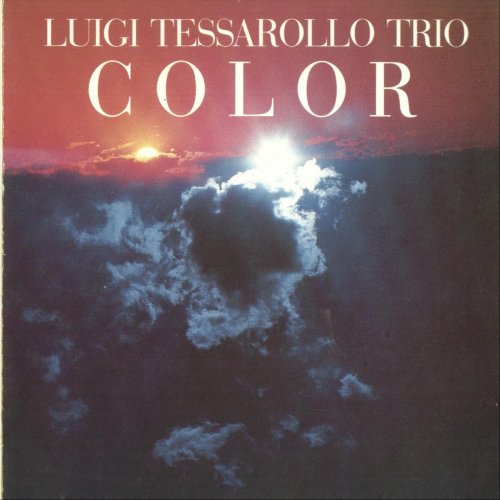
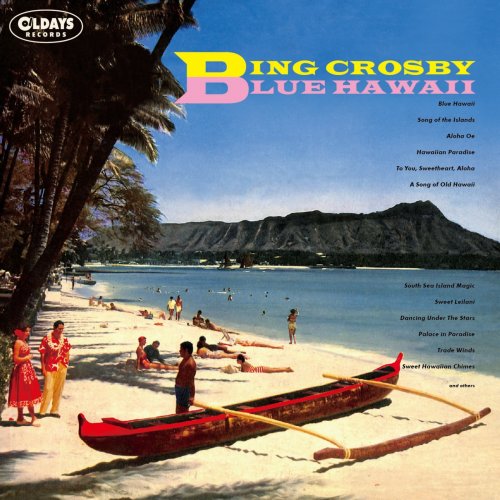

![NYO Jazz - Live in Johannesburg (Live) (2025) [Hi-Res] NYO Jazz - Live in Johannesburg (Live) (2025) [Hi-Res]](https://www.dibpic.com/uploads/posts/2025-12/1765894703_zwp14vk90corb_600.jpg)



